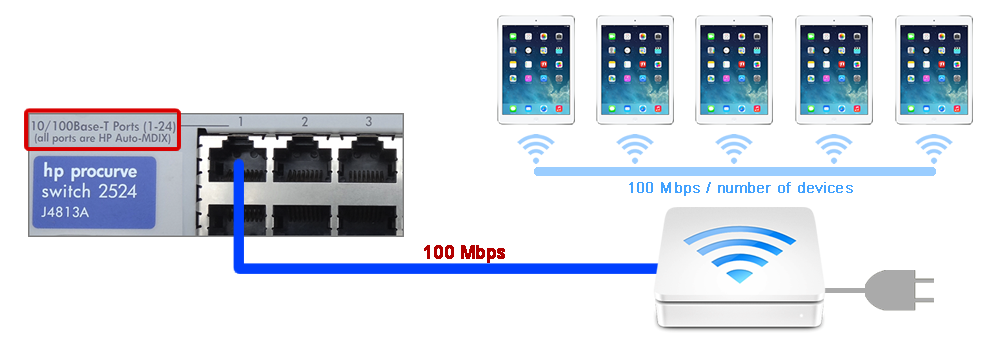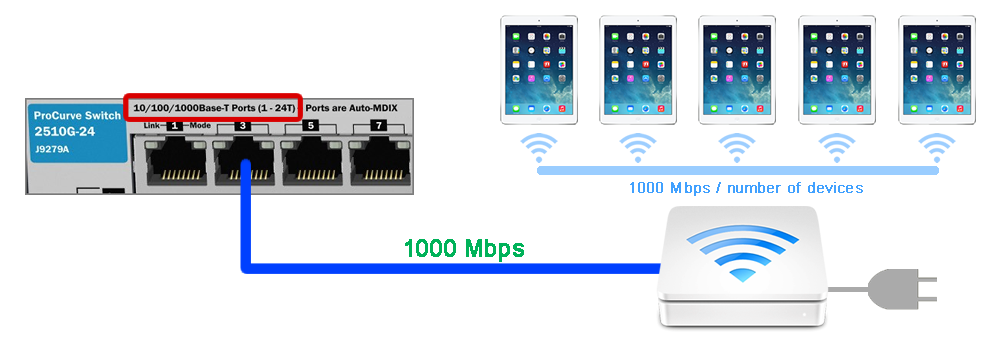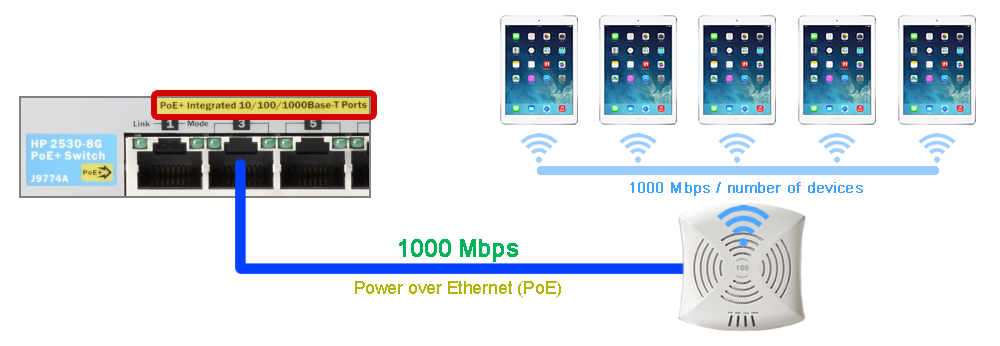![]() If you have 20 computers in a room, each with it’s own Ethernet connection, each computer has it’s own direct link to the network. On a modern network this is most likely a Gigabit connection (1000 Mbps) for each computer. (See below for more info about network speeds.)
If you have 20 computers in a room, each with it’s own Ethernet connection, each computer has it’s own direct link to the network. On a modern network this is most likely a Gigabit connection (1000 Mbps) for each computer. (See below for more info about network speeds.)
If you have 20 wireless devices connecting to a single Wireless Access Point (WAP), those wireless devices are sharing the bandwidth that is available to that single WAP’s connection to the network.
If your WAP is connected to the network (via an Ethernet connection) at 1000 Mbps then each of those 20 wireless devices can expect a maximum concurrent connection speed of 50 Mbps.
If your WAP is connected to the network at 100 Mbps, then each of those 20 wireless devices can expect a maximum concurrent connection speed of 5 Mbps.
That’s a big difference – especially in a BYOT school, where BYOT is essential for online activities.
So, how do you know at what speed your WAP is connected to the network?
There are two potential bottlenecks – the network port on your WAP, and the port on the network switch to which the WAP is connected.
First – check the technical specifications of your WAP on the manufacturer’s web site. Most modern WAPs have a Gigabit connection port.
Next – trace your WAP’s Ethernet network connection back to the switch in the Building Distributor cabinet.
Check the speed of the port that it is connected to in the switch by looking at the switch labelling……
(Click on the images below for a slightly larger version)
A non-PoE WAP connected to a 100 Mb switch (NOT recommended)…
A non PoE WAP connected to a 1000 Mb (Gigabit) switch…
A PoE WAP connected to a 1000 Mb (Gigabit) PoE switch…
Finally, check that the switch to which the WAP is connected is itself linked back to the Campus Distributor (the main switch in the school) with at least a 1 Gb connection. This will often be an optic-fibre link.
What does all this ‘speed’ stuff mean?
 The ‘speed’ of a device’s connection to the network is measured in ‘bits’ of data transferred per second – not to be confused with measuring ‘bytes’ of data stored on your hard disk!
The ‘speed’ of a device’s connection to the network is measured in ‘bits’ of data transferred per second – not to be confused with measuring ‘bytes’ of data stored on your hard disk!
A ‘bit’ is a very small amount of data. Think of a ‘bit’ of data in terms of being equal to one typed character in a text editor.
In modern networks, a ‘bit’ is such a small measure that when data is transferred it is measured in millions of ‘bits’ of data per second – Megabits per second (Mbps)
Old co-axial cable networks (remember those!) could transfer data at up to 10 Mbps. The first generation of Ethernet networks were also operating at around 10 Mbps, but before too long moved to 100 Mbps.
Modern Ethernet networks in schools typically move data around at 1000 Mbps – a capacity which is referred to as a Gigabit.
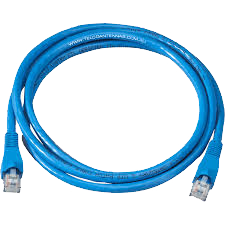 While modern Ethernet cables (Category 5E and more recently Category 6 and 6A) are rated to be able to transfer data at the rate of 1000 Mbps (Gigabit), the electronic equipment to which they are connected determines the overall ‘speed’ of your network.
While modern Ethernet cables (Category 5E and more recently Category 6 and 6A) are rated to be able to transfer data at the rate of 1000 Mbps (Gigabit), the electronic equipment to which they are connected determines the overall ‘speed’ of your network.
All modern computers with an Ethernet network port are able to connect to the network at 1000 Mbps.
However if your Gigabit-capable computer is connected to Gigabit-capable Ethernet cables that are connected to a port on a network switch that only has a 100 Mbps connection capacity, then the maximum speed that your computer will be able to transfer data around the network is only 100 Mbps – the speed of the slowest component in it’s connection path to the network.
This becomes even more critical when considering Wireless Access Points (WAPs), because one WAP is sharing it’s available bandwidth with the multiple wireless devices which are connecting to it.
The current standard for WiFi network equipment is the 802.11 standard, and there are several incarnations of that standard that have developed over time…
 – 802.11b – transfer rates up to 11 Mbps
– 802.11b – transfer rates up to 11 Mbps
– 802.11a and 802.11g – transfer rates up to 54 Mbps
– 802.11n – transfer rates up to 300 Mbps
– 802.11ac – transfer rates up to 1 Gbps (1000 Mbps)
However, these speeds are strictly theoretical. In reality you will be lucky to see transfer rates of even 50% of the claimed peak rate.
Even though the most recent 802.11ac specification claims transfer rates of ‘up to’ 1000 Mbps, a similarly rated Ethernet connection will (in my experience) be much ‘faster’.
However, we do need to keep all this ‘speed’ discussion in perspective….
High-speed data transfer rates become much more relevant if you are logging on to a local server, and transferring files to and from that server.
If you are connecting to the Internet, then your bottleneck will most likely be the bandwidth of your school’s Internet connection, which is shared between all the concurrent Internet connections on your campus.
If your school’s Internet bandwidth is 10 Mbps, and you have 50 concurrent devices connected, that’s 0.2 Mbps per connected device.
If your school enjoys the luxury of a 100 Mbps fibre connection to the Internet, and you have 50 concurrently connected devices, that works out at 2 Mbps per device.
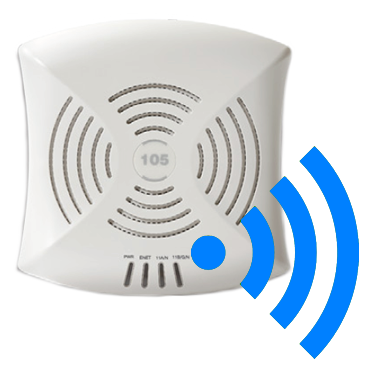 So, if your main purpose in sharing a WAP’s network connection with wireless devices is to access the Internet, then the WAP’s connection to the network may not be the main speed impediment that you are facing.
So, if your main purpose in sharing a WAP’s network connection with wireless devices is to access the Internet, then the WAP’s connection to the network may not be the main speed impediment that you are facing.
20 devices sharing a 100 Mbps connection to the network, be they ever-so-slow, might still be able to transfer data faster than the Internet connection can provide data to the network.
If your main purpose in connecting wirelessly to the network is to log on to, and access data from, a local network server, then WAP bandwidth will be critical.
The best ‘cure’ for Internet access speed across a school campus remains a local proxy server, which caches external web sites locally. This solution is only effective though if multiple students are accessing the same web pages.
All of which is more easily achieved if you maintain a school Intranet site, or a class web page, to act as a ‘gateway’ to ‘funnel’ students to relevant curriculum-related resources. (Rather than sending them on a Google-hunt!)
And which, at the end of the day, all comes back to sound pedagogical practices!

